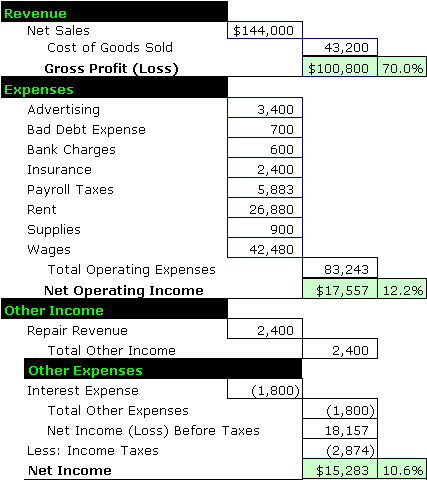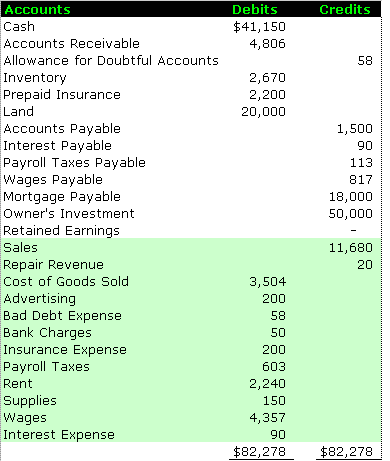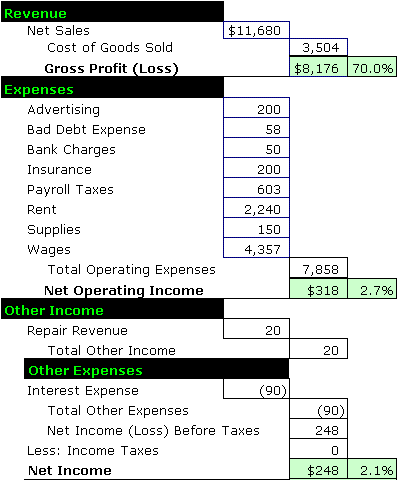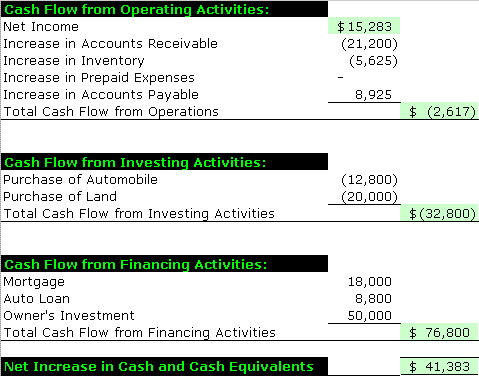Online Accounting Dictionary
| Accounting terms make up the language of business used to measure business performance and profitability. The following accounting dictionary of key accounting terms and accounting definitions decodes the language of business with easy to follow illustrations and examples. |
For a more in depth discussion of each accounting term, simply click the link associated with each term.
The accounting cycle is a ten-step process that consists of the procedures necessary to collect, process, and report economic events in the financial statements for the reporting period.
The accounting equation refers to the main accounting formula that lays the foundation of double-entry bookkeeping. Accounting entries entered on one side of the accounting equation must balance with accounting entries entered on the other side. The accounting equation also represents the relationship of the financial elements listed on the balance sheet, where total assets are listed and balanced with total liabilities and owners equity.
The Accounting Equation
| Assets = Liabilities + Owner’s Equity |
Accounts receivable refers to the current asset listed on the balance sheet that shows the amount owed to the company from customers who purchased products or services on credit.
Accounts receivable turnover measures how quickly a business collects cash for sales on credit, or “turned over” the accounts receivable balance, for the accounting period measured. Accounts receivable turnover is calculated as:
Accounts Receivable Turnover
| Net Credit Sales/Average Net Receivables, |
| where Average Receivables = (Beginning Net Receivables Balance + Ending Net Receivables Balance)/2 |
Accrual accounting refers to the method of recognizing and reporting revenues when earned, whether or not cash is actually received, and expenses when incurred, whether or not cash is actually paid. Compare with the accounting term Cash Accounting.
Accumulated depreciation is the total depreciation expense that accumulates from year to year. Accumulated depreciation accumulates on the balance sheet from period to period as a contra asset account, where it is subtracted from the original cost of the asset to get its book value.
Adjusting entries are accounting entries made at the end of an accounting period to report transactions that occurred but were not recorded during the normal course of business. Adjusting entries are necessary to more accurately represent the financial statements for the reporting period. Adjusting entries are classified as prepayments, accruals, and estimated Items.
Aging of accounts receivable bases the estimate for uncollectible accounts on the number of days the ending accounts receivable balances are outstanding. Aging of accounts receivable is calculated based on the assumption that the longer an account is outstanding, the higher the likelihood that it will not be collected.
Allowance for doubtful accounts is a contra account on the balance sheet that reduces accounts receivable to its net realizable value by subtracting the amount estimated to be uncollectible. When an estimated amount is entered as a journal entry for allowance for doubtful accounts, the associated debit entry, bad debt expense, reduces net income by the same amount for the reporting period.
An Asset is a probable economic benefit obtained or controlled by a business as a result of a past transaction. In accounting terms, a company does not need to own an asset to have control over it. The accounting equation shows us that assets may be owned (called equity), or financed (a liability).
Assets are categorized as Current Assets and NonCurrent Assets.
- Current Assets, or short-term assets, are cash or other assets that a business reasonably expects to convert to cash or consume during the year. Examples are cash, inventory, and accounts receivable.
- NonCurrent Assets, or long-term assets, are assets that a company does not expect to consume or convert to cash within one year. Examples are equipment, buildings, and land.
*see also Property Plant and Equipment*
- Intangible Assets are assets that do not have physical substance, but add long-term value because of the rights and privileges they convey to the business. Intangible assets are classified as noncurrent assets. Examples are patents, copyrights, and trademarks.
Asset Turnover measures the amount of total sales generated from each dollar of assets employed in the business. It is calculated as:
Asset Turnover Calculation
| Total Revenue/Average Assets for Period |
| where Average Assets for Period = (Beginning Assets + Ending Assets)/2 |
Average Collection Period refers to the average number of days it takes a business to collect on accounts receivable. The average collection period measures how well a company is collecting amounts due based on terms of credit (e.g. 30 days, 60 days, 90 days, etc.).
Average Collection Period Calculation
| Average Sales Per Day = Credit Sales or Total Sales/365 |
| Average Collection Period = Accounts Receivable/Average Sales Per Day |
Average Cost refers to the simplest of the four main inventory valuation cost flow methods. Under this method the amount of goods made available for sale (beginning inventory + net purchases) is divided by the number of units available for sale to determine the average price. The average price is then applied to items sold and items in inventory to determine the amount of cost of goods sold and ending inventory.
Bad debt expense is used to expense the estimate for uncollectible accounts receivable on the income statement. The expense is required to match the bad debt with the same credit sales reported for the same period. The bad debt estimate is also deducted from the accounts receivable balance on the balance sheet using its the contra account, allowance for doubtful accounts.
The Balance Sheet is one of the main financial statements reported by businesses. The balance sheet lists the assets, liabilities, and owner’s equity of the business, thereby presenting a “snapshot” of the business as of a particular point in time. The balance sheet balances assets with liabilities and owners equity using the accounting equation:
The Balance Sheet and the Accounting Equation
| Assets = Liabilities + Owner’s Equity |
Book Value is a long-term measure of the financial condition and liquidity of the company. Book value is a measure of assets owned by the business debt-free, and is calculated as:
Book Value
| Assets – Liabilities = Owner’s Equity or Book Value |
For fixed assets, book value equals the acquisition cost of the asset less the accumulated depreciation or amortization measured to date for the asset.
Cash Accounting refers to the method of recognizing and reporting revenue only when cash is actually received, and recognizing expenses only when cash is actually paid. Small businesses and individuals with no inventory primarily use the cash accounting method.
The Cash Flow Statement is one of the required financial statements that shows actual cash inflows and outflows by operating, investing, and financing activities for the reporting period.
Chart of Accounts lists every general ledger account name and account number that a business has available in its accounting system. It categorizes each account into five major groups: asset accounts, liability accounts, equity accounts, revenue and gain accounts, and expense and loss accounts.
Closing Entries are made at the end of a reporting period to bring the income profit and loss statement accounts to zero so the new reporting period will start with zero balances. The difference between revenue and expenses, called net income (or loss), is also closed to retained earnings.
A Contra Account is used to reduce or increase the value of the related asset or liability account on the balance sheet.
- A contra asset account is a credit account used to adjust the value of its related asset (debit) account.
- A contra liability account is debit account used to adjust the balance of the main liability (credit) account.
A contra account is also called a valuation allowance because it is used to adjust the carrying value of the related asset or liability account on the balance sheet.
Cost of Goods Sold is the cost of the inventory that was sold during the accounting period reported on the profit and loss statement. Cost of goods sold is subtracted from total sales to determine gross profit.
A credit is an entry made on the right side of an accounting journal or general ledger account. A credit increases liabilities, revenue, and owner’s equity, and decreases assets and expenses.
Current Ratio measures the short-term condition and liquidity of a business, and is calculated as:
Current Ratio Calculation
| Current Assets/Current Liabilities |
A company should have more than twice the current assets to pay its current debt obligations, or a ratio equal or greater than two. Anything below one is an indication that the company may not be able to meet its short-term financial obligations.
A debit in accounting terms is an entry made on the left side of an accounting journal or general ledger account. A debit increases assets and expenses, and decreases liabilities, revenue, and owner’s equity (also see Debits and Credits).
Debt Equity Ratio measures how much of the company is financed by debt, and is calculated as
Debt Equity Ratio
A higher debt equity ratio means that more assets are financed by debt. Generally, ratios of higher than 1 indicate more risk in financing assets.
Debt Coverage Ratio is a financial ratio used in corporate finance and investment property loans.
The debt coverage ratio measures how much operating income a property, borrower, or business is generating to cover total debt obligations due for the period.
The debt coverage ratio is calculated as:
Calculating the Debt Coverage Ratio
| Operating Income/Total Debt Service |
The higher the debt coverage ratio, the more operating income a company or property has available to cover its total debt obligations.
Depreciation is the expense resulting from spreading the cost of an asset over its estimated useful life. A common depreciation method is the straight line method that divides the cost of the asset by its estimated useful life to determine depreciation each year. Depreciation decreases net income, but is a non-cash expense that has no actual cash outflow.
Double Entry Accounting|Double Entry Bookkeeping refers to the accounting system of recording a transaction by debiting one account and crediting another, where total debits of the transaction equal the total credits. The double entry bookkeeping system is designed to keep the accounting equation in balance.
Equity is the ownership interest in an asset, also called owner’s equity. Equity is the residual interest in the asset after deducting liabilities, represented in the accounting equation as:
Owners Equity
| Assets – Liabilities = Owner’s Equity |
Fair Value is the price that would be received to sell an asset or paid to transfer a liability in an orderly transcation between market participants at the measurement date (FAS 157).
FIFO, or first in first out, is an accounting method based on the assumption that the first goods in are the first goods out or sold for cost of goods sold reporting and inventory valuation purposes. In times of rising inventory prices, FIFO assigns the lower prices to cost of goods sold, and the later, higher prices to inventory. FIFO more closely parallels the actual physical flow of inventory in many industries.
Financial Ratios are numerical values taken from the entity’s financial statements to measure its key performance indicators such as profitability, short-term and long-term financial strength and liquidity, and efficiency of operations.
Fixed Assets, also called Property Plant and Equipment, refers to those assets that are used for a company’s benefit for longer than one year. Examples include vehicles, furniture, land, and equipment.
Free cash flow represents the cash generated by the company from operations, less cash paid for maintaining and expanding its asset base through capital expenditures (operating activities less investing activities on the statement of cash flows). Free cash flow represents the amount of cash left from operations to pay dividends, pay down debt, research and develop new products, and reward investors with available cash.
GAAP is the acronym for Generally Accepted Accounting Principles, which are the conventions, rules, and procedures that set the standard for presenting financial information in the U.S. GAAP has been adopted by nearly all public and non-public businesses in the U.S. and is thus pervasive in the business community
The general journal, or the Accounting Journal, refers to the journal where an accounting transaction is first recorded. The transaction generally consists of the date, the account and explanation, and the amount debited and credited. Accounting entries in the accounting journal are periodically posted to the general ledger to summarize each account.
The General Ledger is a collection of transactions summarized by account. Transactions that are recorded in the accounting journal are posted to the general ledger, which provides a listing of each accounting entry by account as well as the balance for each general ledger account.
The going concern or continuity assumption means that financial statements are produced based on the assumption that the entity will continue to operate indefinitely or at least long enough to execute plans and fulfill commitments. When evidence calls into question the going concern assumption, a different accounting method may be necessary to meet the needs of financial statement users, such as reporting liquidation values for entities entering bankruptcy.
Goodwill refers to the amount paid for an entity in excess of its net assets (total assets – total liabilities). Goodwill is listed on the balance sheet as an intangible asset at historical cost. Similar to land, goodwill is not amortized but is subject to an annual goodwill impairment test.
Gross Profit is the difference between sales and cost of goods sold. It is a measure of a company’s core activities, and is an early measure of business strength before subtracting operating and other expenses.
Gross Profit is commonly measured as a percentage of sales, called Gross Profit Margin calculated as
Gross Profit Margin Calculation
| Gross Profit Margin = Gross Profit/Sales |
Historical Cost refers to recording assets on the balance sheet at the original cost paid, or the historical cost. In the U.S., assets are currently not written up to market value as is commonly done in other countries, but rather carried at the historical cost until sold. The historical cost principle follows the accounting quality of reliability since the original cost of an asset is more easily verified than its current fair market value.
Income Statement is one of the required financial statements, and summarizes the revenue, expenses, and net income for the reporting period.
Interest Coverage measures the ability of a firm to meet its interest payments. The ratio divides operating income (income before interest and taxes) by interest expense.
Calculating Interest Coverage
| Operating Income/Interest Expense |
The larger the interest coverage ratio, the more likely the firm can meet its interest payments. The lower the interest coverage ratio, the greater the risk that the company does not have the necessary operating income to meet its interest obligations.
Inventory Methods are the cost flow assumptions used to value cost of goods sold and ending inventory. The four most common inventory valuation methods are first in first out (FIFO), last in first out (LIFO), average cost, and specific identification.
Inventory Turnover represents the number of times the inventory “turned over” during the period measured.
The Inventory turnover is used to determine whether or not a business is maintaining adequate levels of inventory.
Calculating Inventory Turnover
| Inventory Turnover Ratio = Cost of Goods Sold/Average Inventory |
| where Average Inventory = (Beginning Inventory + Ending Inventory)/2 |
Journal Entry is an accounting entry made in the accounting journal to record an economic event. The accounting entry follows the double-entry accounting system where a debit in one account equals a credit made in another account.
Legal Capital refers to the portion of owners equity and assets that cannot be distributed to shareholders. States requires companies to maintain legal capital to protect creditors’ claims to assets.
The Leverage Ratio calculates the portion of assets that are not owned by the business.
Leverage Ratio
Higher leverage ratios indicate higher debt levels for the company. The leverage ratio is especially useful because it captures all liabilities on the balance sheet, regardless of where or how they are listed. Generally, ratios of higher than 15 are a warning signal that the company has taken on too much debt to finance its assets.
Liabilities in accounting terms are probable future sacrifices of economic benefits from obligations to provide assets or services as a result of a past transaction or event. Liabilities are categorized as Current Liabilities and NonCurrent Liabilities.
- Current Liabilities, or short-term liabilities, are liabilities that a company expects to pay within one year. Examples are accounts payable, current portions of long-term debt, and short term notes payable.
- NonCurrent Liabilities, or long-term liabilities, are liabilities that a company does not expect to pay within one year. Examples are long-term notes such as a mortgage or a lease. For corporations, long-term liabilities may also include bonds payable, pensions payable, and deferred taxes.
LIFO, or last in first out, is an accounting method based on the assumption that the last goods in are the first goods out or sold for cost of goods sold reporting and inventory valuation purposes. In times of rising inventory prices, LIFO assigns the higher prices to cost of goods sold, and the earlier, lower prices to inventory. For this reason, LIFO is often used for tax purposes to lower net income and reportable earnings.
Lower of cost or market refers to measuring inventory items at the lower of cost or market by comparing the current replacement value with the historical cost, and adjusting items down to the replacement cost, or market, or leaving them at historical cost if the replacement cost is greater. The annual LCM adjustment is required so that losses in inventory are matched with earnings for the same period.
Mark-to-market accounting refers to marking certain financial instruments to the market value, thereby bringing gains and losses of the financial instruments onto the income statement.
Matching Principle refers to matching expenses incurred to generate revenues with those revenues recognized and reported for the same accounting period. The aim of the matching principle is to fairly report net results on the income statement by reporting expenses incurred with the revenues they helped generate.
Net Income is equal to the income that a company has earned after subtracting all expenses from total revenue. Net income is commonly measured as a percentage of sales, called net profit margin calculated as:
Net Profit Margin Calculation
| Net Profit Margin = Net Income/Sales |
Net Operating Income is income left after deducting the expenses necessary for operating the business, also called EBIT (earnings before interest and income taxes). Net operating income is commonly measured as a percentage of sales, called operating margin calculated as:
| Operating Margin = Operating Income/Sales |
Net Profit Margin is calculated by dividing net income by sales:
Net Profit Margin
| Net Profit Margin = Net Income/Sales |
Net Realizable Value (NRV) generally refers to the amount of cash expected to be received from the selling of an asset. NRV is also used in the process of valuing inventory at the lower of cost or market (LCM). In this context, NRV is defined specifically as the estimated selling price of an inventory item minus all estimated selling costs and costs to complete the product.
Operating Margin is calculated by dividing net operating income by sales:
Operating Margin
| Operating Profit Margin = Operating Income/Sales |
Owners Equity represents the residual ownership interest in the business after liabilities are subtracted from assets, also called the book value of a company. For corporations, owners equity is called stockholders equity.
Periodic Inventory is an inventory system used to record the amount of inventory on hand periodically, usually once at the end of the year. It maintains the beginning inventory balance throughout the year, and records new inventory purchases in the “purchases” account. At year end a physical count of the inventory is taken to determine the ending inventory balance and the cost of goods sold.
The Perpetual Inventory System maintains a continuous or perpetual record of inventory by recording all purchases, sales, returns, and discounts directly into the inventory account. The perpetual inventory system allows companies to more closely monitor inventory levels throughout the year.
Prior period adjustment is an accounting entry to correct an error in the financial statements for a prior period. GAAP requires that companies exclude the effect of prior period adjustments from current financial statements, and instead report accounting errors as a change to beginning retained earnings for the current period.
Property Plant and Equipment (PP&E), see Fixed Assets.
Quality of Earnings refers to how closely income correlates with cash flow. The higher the correlation between net income and cash flow, the higher the earnings quality.
QuickBooks Solutions For Your Industry
The Quick Ratio, also called the “acid test,” is a more stringent measure of short-term liquidity than the current ratio. The quick ratio subtracts inventories and prepaid expenses from current assets before dividing by current liabilities:
Quick Ratio Calculation
| (Current Assets – Inventory – Prepaid Expenses)/Current Liabilities |
Real or Permanent Accounts are those accounts listed as assets, liabilities, or owner’s equity on the balance sheet. Unlike nominal or temporary accounts, real accounts accumulate balances in the account for the life of the account, and are not closed at the end of a reporting period. Examples of real accounts are cash, accounts receivable, accounts payable, and retained earnings.
Retained Earnings represent the amount of undistributed net earnings accumulated in an entity since its inception. Retained earnings are increased primarily from net profits, and decrease primarily from net losses or distributions of earnings in the form of dividends.
Return on Assets measures how well a company has invested its assets to return a profit. It is calculated by dividing net earnings by total assets:
Return on Assets Calculation
Return on Equity measures how well the company used its owners equity to return a profit in the business, calculated as:
Return on Equity Calculation
| ROE = Net Income/Average Stockholders or Owners Equity |
| where Average Equity = (Beginning Equity + Ending Equity)/2 |
Reversing Accounting Entry is an optional accounting entry made at the beginning of the next accounting period to maintain consistency in the accounting cycle. Reversing entries reverse an adjusting entry made at the end of the prior period if the adjusting entry increased an asset or a liability account.
A Roth IRA is an individual retirement arrangement that allows you to make Roth IRA contributions after you pay taxes, and then grow the contributions and earnings tax-free. This is the opposite of a traditional IRA where you take the tax deduction for the year of the contribution, but are later taxed on all withdrawals and earnings.
The Statement of Retained Earnings reports the changes in the retained earnings account from one period to another. Since GAAP requires that companies report changes in all equity accounts for the period, companies often combine the statement of retained earnings with changes in other equity accounts to produce the statement of stockholders equity.
The Statement of Stockholders Equity reports changes in retained earnings and any additional changes in equity accounts for the accounting period. The statement of stockholders equity is commonly used to meet GAAP’s requirement that companies report all changes in equity accounts.
Stockholders Equity is the shareholders residual interest in a corporation after liabilities are subtracted from assets. Changes in stockholders equity are reported on the statement of stockholders equity.
A Traditional IRA is an individual retirement arrangement that allows you to make tax-deductible contributions to your retirement plan depending on your income level, and whether or not you participate in a company retirement plan like a 401(k).
Treasury Stock refers to the stock that a company buys back without reissuing them or canceling them, but rather holds them in the treasury. When a company repurchases its own stock (treasury stock), net assets and stockholders equity decrease. There are mainly two accounting methods for accounting for treasury stock:
- Accounting for Treasury Stock – Cost Method
- Accounting for Treasury Stock – Par Value Method
The Trial Balance Sheet provides a listing of the account balances in the general ledger to verify the equality of total debits and credits, and to facilitate the next step in the accounting cycle. Generally there are three trial balances produced during the accounting cycle:
- The Unadjusted Trial Balance verifies the equality of total debits and credits before adjusting entries are made, and lists each account balance for the reporting period to facilitate the adjusting entry process.
- The Adjusted Trial Balance verifies the equality of total debits and credits after adjusting entries are made, and lists the account balances to facilitate the period close.
- The Final Trial Balance verifies the equality of total debits and credits after closing entries are made, and provides a listing of each account balance that is carried forward into the next reporting period.
Working Capital measures immediate liquidity of a business, and is calculated by subtracting current debt from current assets,
Working Capital
| Working Capital = Current Assets – Current Liabilities |
From Accounting Terms Back to the Online Accounting and Business Accounting Home Page





